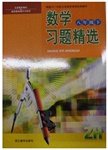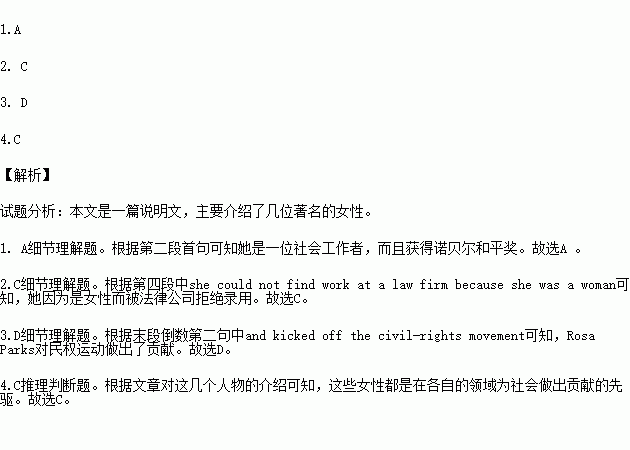题目内容
阅读下列短文,从每题所给的四个选项(A、B、C和D)中选出最佳选项,并在答题卡上将该项涂黑。
A
You probably know who Marie Curie was,but you may not have heard of Rachel Carson.Of the outstanding ladies listed below,who do you think was the most important woman of the past 100 years?
Jane Addams(1860-1935)
Anyone who has ever been helped by a social worker has Jane Addams to thank.Addans helped the poor and worked for peace. She encouraged a sense of community(社区)by creating shelters and promoting education and services for people in need In 1931,Addams became the first American woman to win the Nobel Peace Prize.
Rachel Carson(1907-1964)
If it weren’t for Rachel Carson, the environmental movement might not exist today.Her popular 1962 book Silent Spring raised awareness of the dangers of pollution and the harmful effects of chemicals on humans and on the world’s lakes and oceans.
Sandra Day O’Connor(1930-present)
When Sandra Day O’Connor finished third in her class at Stanford Law School, in 1952,she could not find work at a law firm because she was a woman. She became an Arizona state senator(参议员) and ,in 1981, the first woman to join the U.S. Supreme Court. O’Connor gave the deciding vote in many important cases during her 24 years on the top court.
Rosa Parks(1913-2005)
On December 1,1955,in Montgomery,Alabama,Rasa Parks would not give up her seat on a bus to a passenger. Her simple act landed Parks in prison.But it also set lff the Montgmery bus boycott. It lasted for more than a year, and kicked off the civil-rights movement. “The only tired I was, was tired lr giving in,”said Parks.
1.What is jane Addams noted for in history?
A. Her social work.
B. Her lack of proper training in law.
C. Her efforts to win a prize.
D. Her community background.
2. What is the reason for O’Connor’s being rejected by the law firm?
A. Her lack of proper training in law.
B. Her little work experience in court.
C. The discrimination against women.
D. The poor financial conditions.
3. Who made a great contribution to the civil-rights movement in the US?
A. Jane Addams. B. Rachel Carson.
C. Sandra Day O’Connor. D. Rosa Parks.
4. What can we infer about the women mentioned in the text?
A. They are highly educated.
B. They are truly creative.
C. They are pioneers.
D. They are peace-lovers.
 习题精选系列答案
习题精选系列答案
